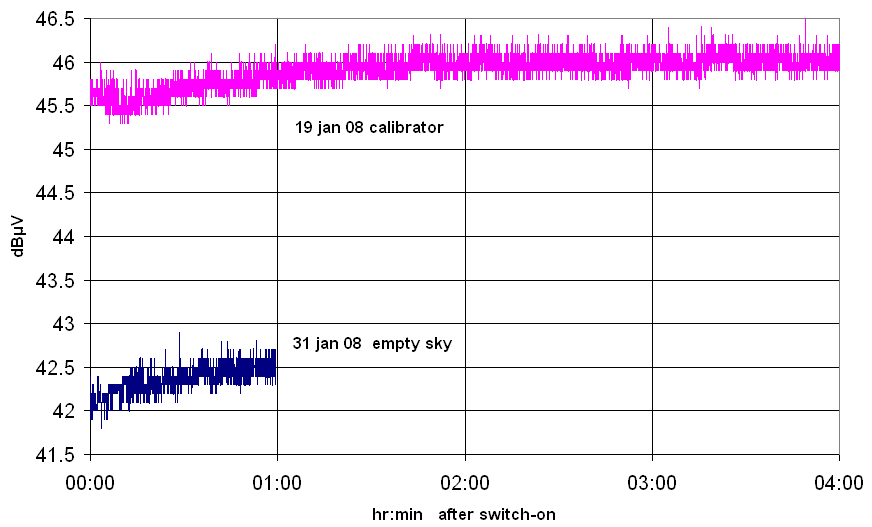
Noise and Sensitivity
Joachim Köppen Strasbourg 2008
The basic limitation of any radio telescope (or communications system) is the noise produced in the active components (transistors) of the receiver's front end. In principle, all components such as resistors also produce thermal noise, but usually the contribution from the active components are far more dominant. The receiver's noise level is expressed as the 'noise figure', and is given in dB over the thermal background. Our LNB is specified to have a noise figure of 0.2 dB, hence it produces noise which corresponds to a temperature of 10**0.02 = 1.05 times the ambient temperature. For comparison, the RadioJove receiver has a noise figure of about 6 dB, thus with a noise level corresponding to 4 times 300 K!
In order to detect an incoming signal, its power must exceed that internal noise level. For a mere detection of a telegraphy signal, it needs to be 10 times stronger, thus having a signal-to-noise ratio of 10 dB. For reliable voice communication, the S/N ratio must be at least 20 dB, and for a good TV picture, one needs at least 40 dB. If the signal is as weak as the noise, one must use sophisticated techniques to dig out the signal. One method is to integrate or average the signal over a sufficiently long time: since the noise has a random nature, it would tend to average out.
The power density of thermal noise is computed from
In the Calibration Report there is a description of how to determine the sensitivity of the system.
Careful measurements of the Sun, Moon, and the calibration source established a consistent system temperature of about 170 K for the ESA-Dresden telescope after the re-straightening of the LNB arm. The small (60 cm) dish of the simple approach gives a system temperature of 290 K. This is described in our Report, which also includes some corrections of the designers' calibration report mentioned above.
See Flux Calibration and System Temperature.
Receiver drift:
The noise produced by the receiver front end, i.e. the LNB, is not constant. While it may well change with ambient temperature, this may not be of great importance, because any measurement of the Sun or Moon would always be accompanied by measuring the flux calibrator and the noise background of the empty sky - preferentially before and after an observation. The characteristics of the LNB may change in time; so far we have not noticed any effect by exposure to the sun's radiation which could well cause a heating of the LNB. Also, differences between winter and summer have not been noticed.
However, one pronounced effect has been identified: The heating up of the LNB electronics after switching on the system. As can be seen from the plot below, both the sky noise and the signal level from the flux calibrator increase by about 0.5 dB in the first one to two hours after switching on.

Since this increase proceeds quite steadily, it is possible to obtain good measurements almost right after starting up the system. However, one has to be aware that the measured levels have an upward drift. If care is taken to get frequent flux calibrations and sky noise measures, one may interpret the data by interpolation of calibration and background values.
One may avoid the inconvenience of making these assumptions and executing a more involved analysis, by taking measurements only after the system has reached a stable condition, i.e. after about two hours. However, one is well advised to look out for any unexpected variations, and it is mandatory to convince oneself that the system is operating in a stable way!
Open Issues and Puzzles:
| Top of the Page | Back to the MainPage | to my HomePage |
last update: Apr. 2013 J.Köppen